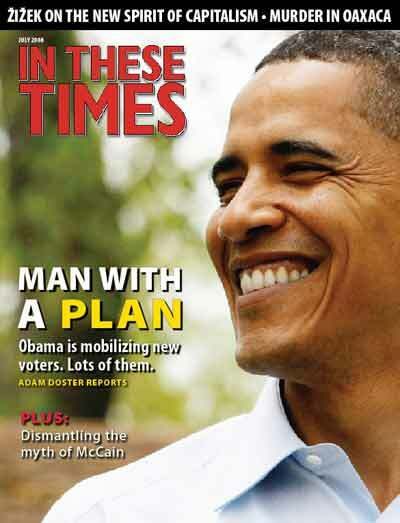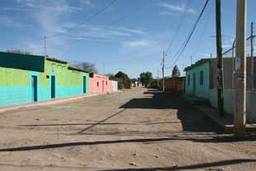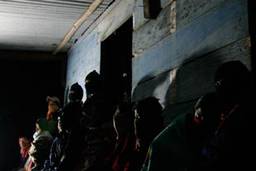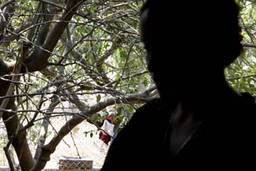Death Squads in Oaxaca
The Mexican government ignores the assassination of two community radio activists
John Gibler
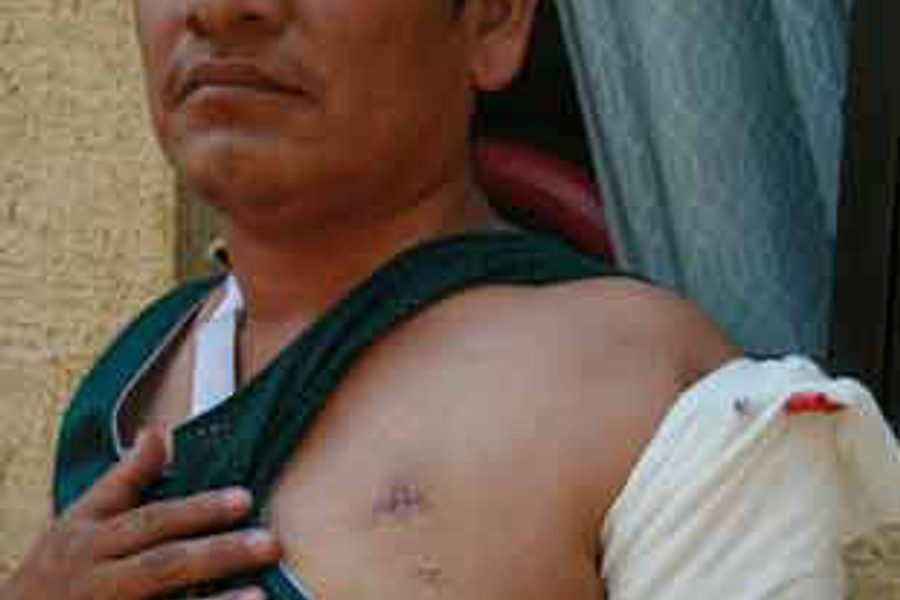
SAN JUAN COPALA, Mexico – Driving through the back roads of western Oaxaca state in southwestern Mexico, one could often hear 94.9 FM, Radio Copala, “The Voice that Breaks the Silence.” In one of the station’s tag-lines played several times a day, a slow, piercing violin gave way to the languid voice of a woman singing in Spanish: “I am a rebel because the world has made me that way, because no one ever treated me with love, because no one ever wanted to listen to me.”
But amid such overwrought sadness, a strong – and perhaps hurried – young woman’s voice would interrupt: “Some people think that we are too young to know.” And then a second young female voice interjects: “They should know that we are too young to die.”
Those voices belonged to Teresa Bautista Merino, 24, and Fel’citas Mart’nez Sánchez, 21, two of six young producers and hosts at Radio Copala – a project of the recently autonomous municipality of San Juan Copala, and the first radio station to broadcast in both Spanish and the Triqui indigenous language.
The broadcast launched in January. By April, Teresa and Fel’citas were dead.
Political Assassination
On April 7, Teresa and Fel’citas rode in the backseat of Fel’citas’ cousin Faustino Vásquez’s car on their way to a community radio workshop in Oaxaca City. They held Faustino’s 2-year-old son, August’n, between them. In the front passenger seat rode Faustino’s wife, Cristina, and their 4-year-old son, Jaciel.
“We were going downhill, with a bald cliff on the right,” says Faustino. “Before we went down, I noticed an access road from the highway and said, ‘Look at that new white pickup parked there.’”
Seconds later, as they rounded the curve at the bottom of the hill, Faustino looked again to the right. “There were seven men up on the hill,” he says, “and they began to shoot at us.”
Bullets pierced the windshield, hitting Faustino’s left wrist and shoulder, and grazing his right arm, leg and head. Two bullets also grazed the back of Jaciel’s head; he lost consciousness. A bullet shattered Cristina’s left arm.
“The motor shut off,” Faustino recalls. “I tried to start it again, but it wouldn’t go. I took the key and ran. When I ran, Teresa and Fel’citas were still alive. I shouted, ‘Run! They’re shooting at us!’”
State police later collected some 20 spent shells from AK-47 assault-rifles by the side of the road. The gunmen had descended the embankment and had shot out the back of the car. Teresa and Fel’citas died almost instantly. Faustino, Cristina and their two sons survived.
Violence among the Triquis
For centuries, the small Triqui indigenous region – a 300 square-mile green oasis situated in the middle of the dry and eroded indigenous Mixteca region of western Oaxaca – has been known for endemic violence. The Triquis resisted Spanish colonial incursions and, in 1823, were the first indigenous people to rise up against the independent Mexican state, successfully beating back an attempt to evict them from their land.
After the Triquis were victorious in defending their territory in two wars – one in 1823, the other in 1843 – the Mexican government decided to shift its approach from direct, armed confrontation to a divide-and-conquer strategy, says Francisco L – pez Bárcenas, a Mixtec indigenous lawyer, historian and author of the forthcoming, San Juan Copala: Political Domination and Popular Resistance.
From the late 19th century to the present, internal divisions in the Triqui region, fomented by the state government, have led to cycles of political killings and massacres.
Although local Oaxacan governors have long attributed the violence to indigenous cultural practices, Lopez Bárcenas argues that it stems from the “social decomposition that comes on the heels of the political and economic domination of the state. And it has a history.”
That history, he says, has pit Triqui communities – fighting to maintain autonomy – against those collaborating with the state.
One early battle began over the control of land for coffee production. In the 1920s, non-indigenous speculators brought coffee into the region, often paying Triqui farmers with guns and alcohol. Some Triqui coffee farmers assassinated other Triquis who refused to substitute their traditional corn, bean and squash production for coffee.
“The state first tried to submit the Triquis economically with the transition to coffee production,” says Lopez Bárcenas. “They then tried to submit them politically with the division [in 1948] of the Triqui region into five municipalities and the militarization of the area.”
In the ’70s, the Triqui council of elders tried to end the violence by passing down their community powers to a coalition of young Triqui men who pledged to peacefully unite the region. That peace lasted less than two years. One of the newly appointed communal authorities aligned with the ruling Institutional Revolutionary Party (PRI) and killed off his rivals.
During the ’80s, violence escalated again when the Triqui created various political organizations, such as the Movement for Triqui Unification and Struggle (MULT, by its Spanish acronym). The group, one of the most powerful, started as a land-defense organization that directly confronted the state. By the ’90s, however, the organization evolved into a quasi-paramilitary group controlled by a non-Triqui man, Heriberto Pasos, who had longstanding connections to the Oaxaca state government.
Pedro Matias, a Oaxacan journalist who has reported on the region for more than 10 years, says, “Pasos runs the MULT with a leftist discourse but, in reality, they act in relation to the powers of the state.” After the group took control of the region, the killings started again, he says.
In 2006, more than half of the Triqui region split off from the MULT, creating the MULTI (the added “I” standing for “Independent”).
Later that year in June, when Oaxaca erupted in a civil disobedience uprising to protest Gov. Ulises Ruiz’s repression of striking teachers, the MULTI joined the protesters’ organization, the Oaxaca Peoples’ Popular Assembly, or APPO, while the MULT sided with the state government.
The first people killed during the conflict were three Triquis from the MULTI, who were shot down by men wielding AK-47s while on their way to an APPO meeting in Oaxaca City.
“The MULT participated directly in the death squads in Oaxaca in 2006,” says Lopez Bárcenas.
A community radio station is born
Jorge Albino Ortiz had a program on Radio La Ley, the APPO station, during the 2006 uprising. “We observed how the radio called people to participate in the various actions of the movement and we wanted to do something like that in our region,” he says.
As a result, Radio Copala was born.
Albino Ortiz, who is coordinator of Radio Copala, says the station decided to have three men and three women working at the radio because one of its primary tasks was to encourage women’s participation in the new autonomous municipality of San Juan Copala – which MULTI created after it dissolved.
The town, located in the Triqui region, is an amalgamation of 20 Triqui communities. San Juan Copala is cut off from all relations with the Oaxaca state government: it has no cell phone service or telephone lines. Which is why Radio Copala, with its approximately nine-mile radial reach, was often the only source of news, and frequently focused on themes of autonomy and indigenous rights.
“When we started, we felt really excited to have a radio station in Copala,” says Yanira Vásquez, who worked with Teresa and Fel’citas at the station. “Women do not participate much and we were just beginning to promote women’s participation in assemblies and meetings and to include their perspectives and interviews about how they see what is happening in the region.”
Radio Copala is currently playing only music, though it plans to continue its social and political programming soon. Two signs on the door to the station bear the names of Teresa and Fel’citas, declaring: “You will always be present.”
Impunity
On April 7, news of the killings traveled around the globe in a matter of hours via e-mail and the Internet. Dozens of national and international human rights organizations, reporters’ defense groups and even the United Nations and the Inter-American Commission on Human Rights condemned the assassinations and demanded that the Mexican government conduct a rigorous investigation and punish the guilty.
But three weeks after the killing, no government official had gathered testimony from the surviving witnesses.
On April 18, Oaxaca State Attorney General Evencio Mart’nez told reporters: “What is clear is that the attack was not directed at the two announcers, but at the person [Faustino Vázquez] who was driving the vehicle.”
Not true, says Faustino, who says state investigators never interviewed him. Instead, he had to arrange a meeting to give his testimony. Faustino also points out that he was able to easily escape without being pursued, while gunmen appeared to target Teresa and Fel’citas.
On April 21, Juan de Dios Castro Lozano, a sub-director of the federal attorney general’s office, told a group of Mexican and international human rights investigators that the two young women were not really journalists – they had no journalism degree – but were housewives who just changed the music when callers made requests at the station. His comments provoked immediate criticism, including from the committee of the National Journalism Award, which had given the accolade to Teresa and Fel’citas posthumously.
Mar’a Dolores Par’s, a professor of rural sociology at the Autonomous University of Mexico, says that the state’s claim that Faustino, and not the two women, was the real target of the killers is “absurd,” though she says that women have not been targeted in regional violence before.
Dolores Par’s, who has worked with Triquis in Oaxaca and Triqui migrants in California for seven years, says the state government goes into the region to foment violence and then “washes its hands of it with theories that the violence comes from the nature of the Triquis themselves.”
“I feel certain that the young women were assassinated for their work with the radio station.” Then adds: “The intention has always been to strip the Triquis of their land.”
Faustino Vásquez and his family have now been thrust into the heart of this violence.
“I am scared,” Faustino says. “I will have to be careful now, no more living life like somebody who can just go wherever he likes. If they see me out there, certainly they’ll execute me.”
Asked if he has any hope for justice, Faustino responds: “With the help of human rights organizations, with the help of journalists, radio, television, with all that putting pressure on the state and federal governments, maybe there will be justice.”
